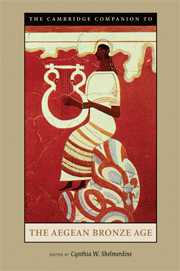Book contents
- Frontmatter
- 1 Background, Sources, and Methods
- 2 The Early Bronze Age in Greece
- 3 The Early Bronze Age in the Cyclades
- 4 Early Prepalatial Crete
- 5 Protopalatial Crete
- 6 The Material Culture of Neopalatial Crete
- 7 Minoan Culture: Religion, Burial Customs, and Administration
- 8 Minoan Crete and the Aegean Islands
- 9 Minoan Trade
- 10 Early Mycenaean Greece
- 11 Mycenaean Art and Architecture
- 12 Mycenaean States
- 12A Economy and Administration
- 12B Late Minoan II to IIIB Crete
- 13 Burial Customs and Religion
- 14 Mycenaean Greece, the Aegean and Beyond
- 15 Decline, Destruction, Aftermath
- Glossary
- Select Bibliography
- Index
- Plate section
12B - Late Minoan II to IIIB Crete
from 12 - Mycenaean States
Published online by Cambridge University Press: 28 November 2010
- Frontmatter
- 1 Background, Sources, and Methods
- 2 The Early Bronze Age in Greece
- 3 The Early Bronze Age in the Cyclades
- 4 Early Prepalatial Crete
- 5 Protopalatial Crete
- 6 The Material Culture of Neopalatial Crete
- 7 Minoan Culture: Religion, Burial Customs, and Administration
- 8 Minoan Crete and the Aegean Islands
- 9 Minoan Trade
- 10 Early Mycenaean Greece
- 11 Mycenaean Art and Architecture
- 12 Mycenaean States
- 12A Economy and Administration
- 12B Late Minoan II to IIIB Crete
- 13 Burial Customs and Religion
- 14 Mycenaean Greece, the Aegean and Beyond
- 15 Decline, Destruction, Aftermath
- Glossary
- Select Bibliography
- Index
- Plate section
Summary
Introduction
In chronological overviews of the Aegean Bronze Age, after discussions of the “climax” of the Minoan civilization in the Neopalatial period, the focus of interest often shifts to the incipient palace-states of the Greek mainland, and, with the exception of Knossos, Crete becomes something of a backwater, viewed as an increasingly marginalized region in a now Mycenocentric world. Yet in fact, although interactions with the mainland were indeed intensive, Crete’s rich archaeological record has revealed an equally significant picture of internally focused, fast-paced political and cultural changes.
The ceramic phases LMII-IIIB cover the period from the fifteenth-century horizon of destructions that devastated most of the Minoan palaces (marking the end of what we term the Neopalatial period) down to the later thirteenth century, which witnessed a general disintegration of urban centers on the island. For reasons explained below, opinions differ among archaeologists regarding the appropriate “political” terminology to use - the labels “Final Palatial,” “Third Palatial,” and “Postpalatial” have all been applied to all or part of this period. This discussion will use the ceramic phases as chronological labels, as a more neutral alternative, but the issue of Crete’s changing political organization is nevertheless important in any analysis of this period, involving as it did the demise of state societies on the island.
- Type
- Chapter
- Information
- The Cambridge Companion to the Aegean Bronze Age , pp. 310 - 326Publisher: Cambridge University PressPrint publication year: 2008



